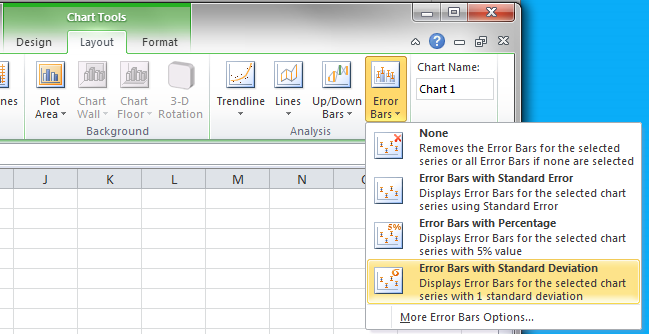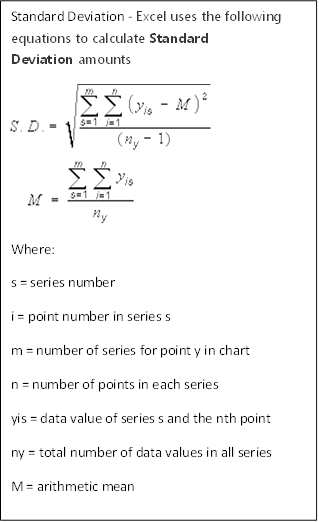

- HOW TO INCLUDE STANDARD DEVIATION IN EXCEL GRAPH HOW TO
- HOW TO INCLUDE STANDARD DEVIATION IN EXCEL GRAPH SERIES
Finally, apply the formatting to the other columns by highlighting the cells containing the upper and lower error bounds, and dragging the blue square on the bottom right of the box across the rest of your data columns.
HOW TO INCLUDE STANDARD DEVIATION IN EXCEL GRAPH SERIES
In this example, I subtracted the standard error (cell c4) from the average (cell C2).įind the upper and lower error bound for every time series in your data. Similarly, subtract the error from the average to find the lower bound. So in our example, I added the average (cell C2) and the standard error (cell c4).
HOW TO INCLUDE STANDARD DEVIATION IN EXCEL GRAPH HOW TO
you can use one of the existing measures, such as standard error or standard deviation. This tutorial shows how to compute and interpret the mean, the median, the standard deviation and other descriptive statistics for quantitative data in. To find the upper bound of an error band, simply add the error to the average. In Spotfire, you can use error bars in bar charts, line charts. STEP 2: FIND THE UPPER AND LOWER BOUNDS OF EACH ERROR BAND The mean, or average, is represented by the Greek letter, in the. You can do this quickly by using the autofill option, or use the fill handle and. The following graph of a normal distribution represents a great deal of data in real life. In the cell below it enter 36 and create a series from 35 to 95 (where 95 is Mean + 3 Standard Deviation). This value can be calculated using Mean 3 Standard Deviation (65-310). Select the dataset labels and the mean values (hold down CTRL to select multiple ranges) and then create the type of chart you require. Here are the steps to create a bell curve for this dataset: In cell A1 enter 35. Enter a standard deviation This will give you the same value for each bar, the same value above and below the bar, and will be centered on the mean (average) of the sum of all the columns. Use the AVERAGE function for the mean calculation and STDEV or STDEV.S to calculate the standard deviation within each data set.

It explains in detail how to use a stacked area chart for colored bands as. Then hop over to Jon Peltiers site and follow his tutorial on Excel Charts With Horizontal Bands. The Excel function STDEV () will help with the calculation. In the example above, I use standard error but you could also use a confidence interval, standard deviation, variance, or any other measurement of uncertainty.īelow the rows containing the averages and standard deviations, we will add additional rows for the upper and lower bound of each error band. Start by creating mean and standard deviation columns. Yes, youll need to work out the standard deviation values and plot these as a background to the chart. The rows should contain the averages and uncertainty measurements associated with each condition and the columns should contain measurements over time.


 0 kommentar(er)
0 kommentar(er)
